Today’s off-road SUV market is heavily influenced by nostalgia. Just observe the popularity of Jeeps and Broncos, and you’ll see it’s undeniably true. Toyota understands this trend perfectly, which explains why they resurrected the Land Cruiser for 2024. Its return wasn’t entirely unexpected, as capitalizing on the retro 4×4 wave is a smart business move, given that nostalgia is a significant selling point in this segment.
Now, while that might sound like a harsh assessment of the new Land Cruiser, it’s not to say it’s a poor vehicle. It isn’t. However, if emotional connection and the feeling a vehicle evokes are major factors in the buying decision—and for many, they are—it’s hard to see this Land Cruiser as the top choice. Considering my test model’s MSRP of $71,809, which is actually about $200 more than the Lexus GX I reviewed the previous week, it’s questionable why someone would opt for the Toyota.
The common counter-argument is, of course, “Because it’s a Land Cruiser.” But that legacy alone shouldn’t suffice. While the new hybrid J250 shares the iconic name with its distinguished predecessors, its Prado origins are undeniable. These roots become even more apparent in the higher-priced trims, and at that price point, the Lexus GX consistently emerges as the more compelling option.
Toyota Land Cruiser: Back to Basics
Toyota offers a vast lineup of crossovers and SUVs in the U.S. market, making the Land Cruiser now just one of many. They also produce five body-on-frame vehicles: the Tundra, Tacoma, Sequoia, 4Runner, and Land Cruiser. By 2025, all of these will share Toyota’s TNGA-F architecture, not to mention the Lexus GX and LX which also share this platform. This abundance of similar vehicles means the Land Cruiser faces an uphill battle to truly differentiate itself from the start.
Visually, the new Land Cruiser is distinctive. It’s available in two front-end styles: round headlights for the base 1958 trim and rectangular ones as featured on this test model. The optional two-tone paint with a white roof is a stylish touch. The boxy design, particularly from the rear-three-quarter view, is appealing, although it could benefit from a slightly higher stance and larger tires to enhance its rugged appearance. Fortunately, upgrading tires is often the first modification Land Cruiser enthusiasts make.
The interior of the Land Cruiser presents a mixed experience. A digital gauge cluster comes standard across all trims. While the base 1958 model gets an eight-inch infotainment screen, higher trims boast a larger 12.3-inch display. However, the lower trims only include a six-speaker sound system. The $4,600 Premium Package upgrades to a 14-speaker JBL Premium Audio system (among other features), but this might not be necessary for all buyers. Regardless of trim, the Land Cruiser comfortably accommodates four adults, and up to five with children. Despite cupholders and USB-C ports in the cargo area, a third-row option is not available.
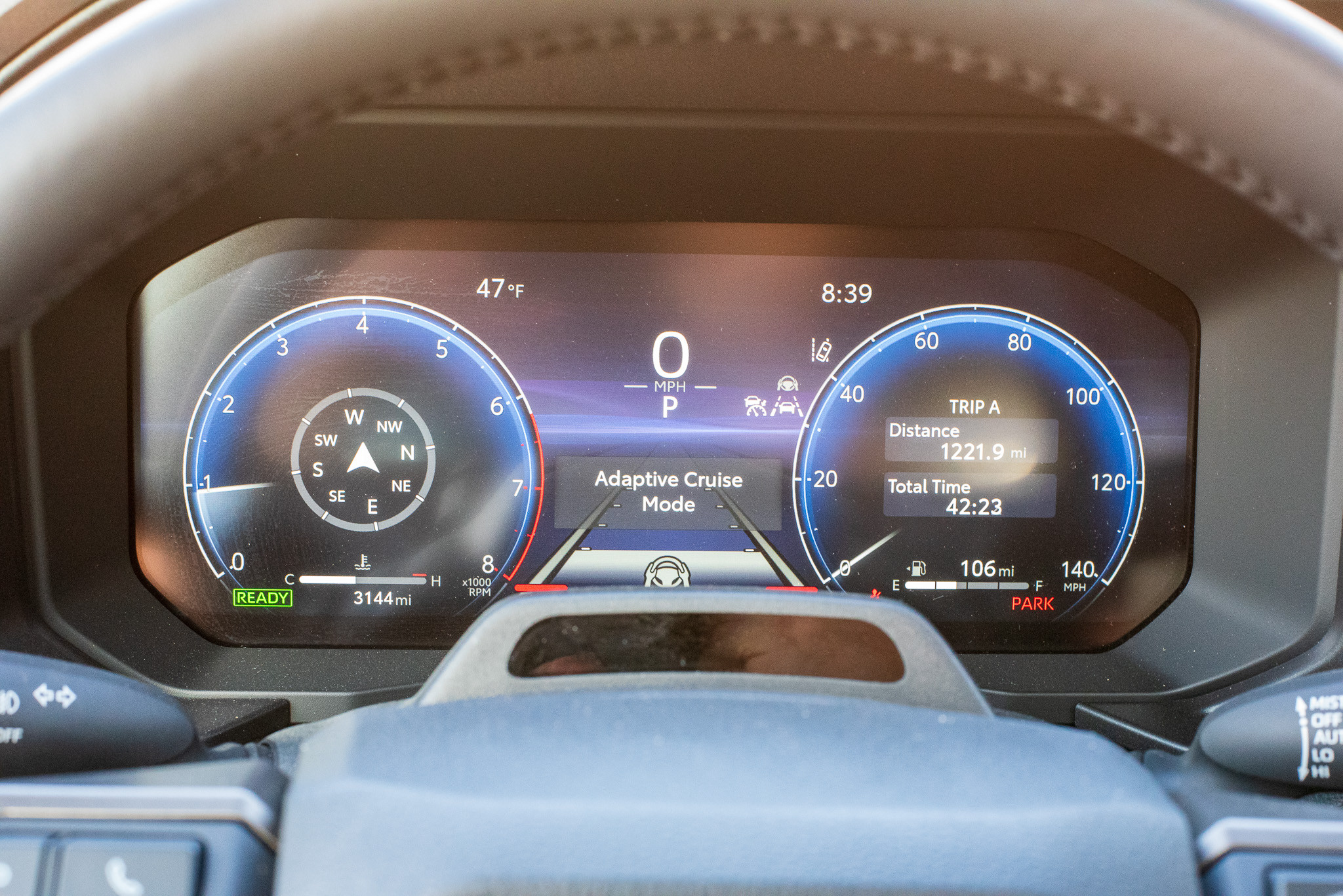 Rear interior view of the 2024 Toyota Land Cruiser showcasing the cargo space and rear seats.
Rear interior view of the 2024 Toyota Land Cruiser showcasing the cargo space and rear seats.
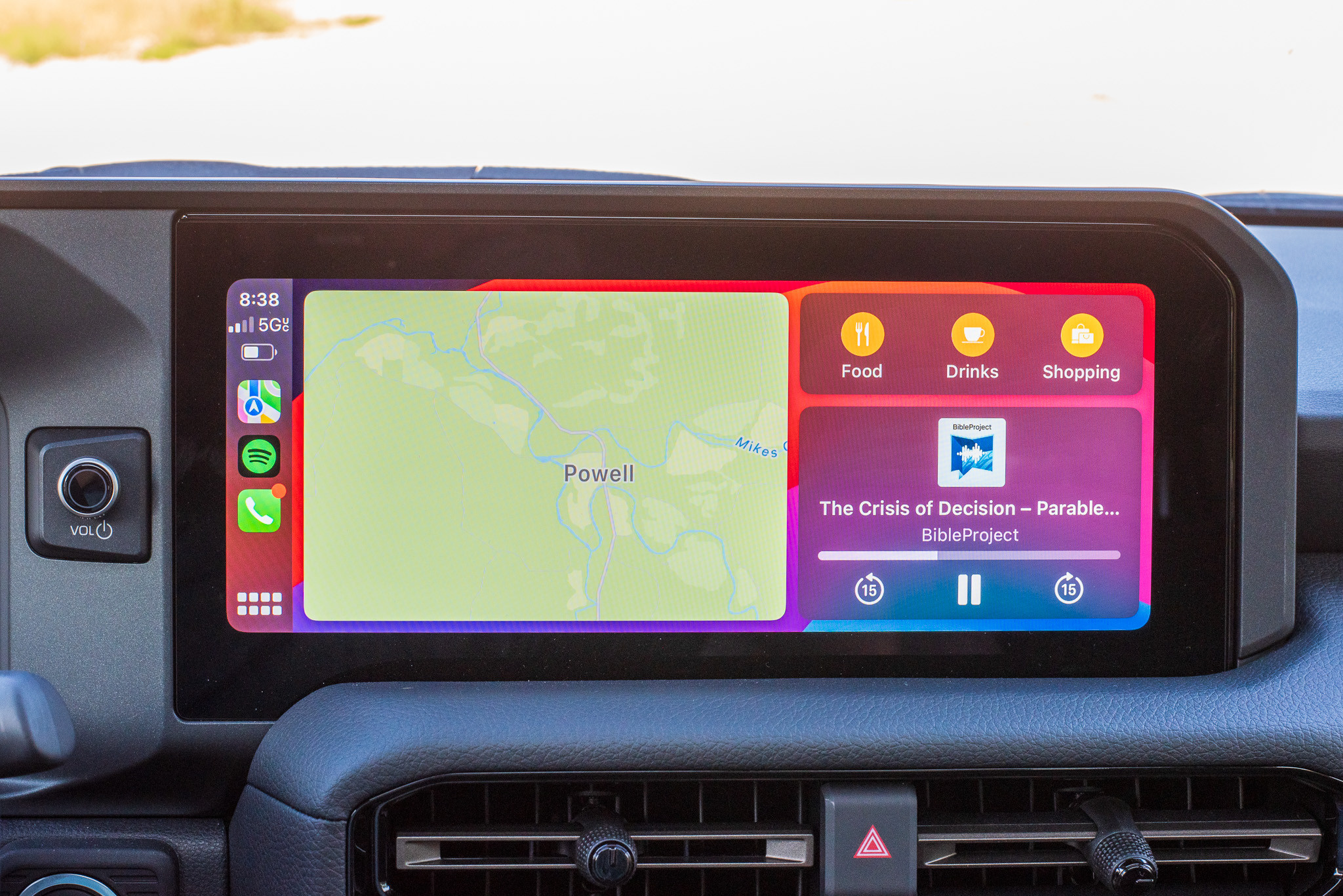 Close up of the center console and gear selector in the 2024 Toyota Land Cruiser.
Close up of the center console and gear selector in the 2024 Toyota Land Cruiser.
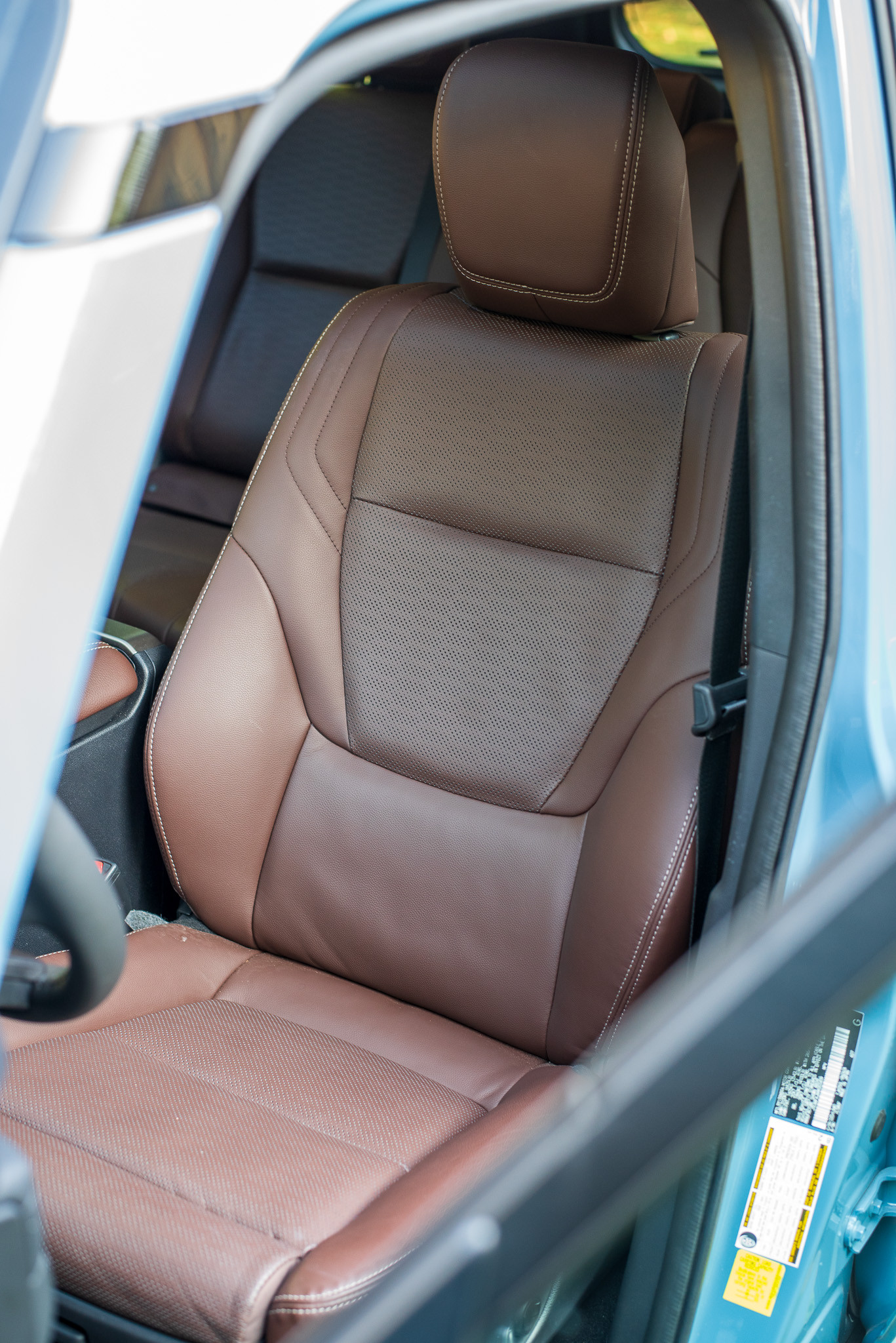 Front interior view of the 2024 Toyota Land Cruiser cabin highlighting the steering wheel and dashboard layout.
Front interior view of the 2024 Toyota Land Cruiser cabin highlighting the steering wheel and dashboard layout.
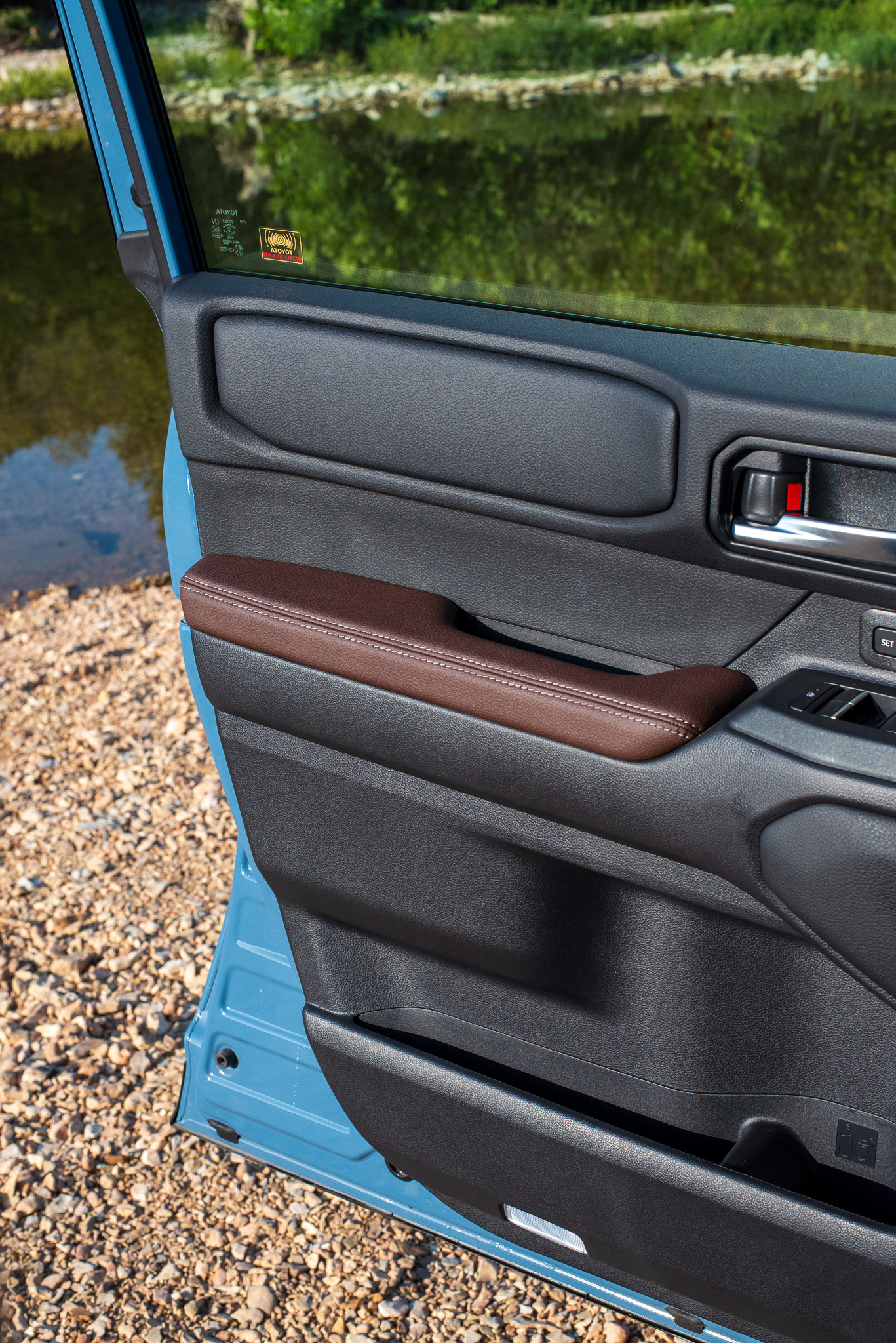 Side interior view of the 2024 Toyota Land Cruiser showing the door panel and seat design.
Side interior view of the 2024 Toyota Land Cruiser showing the door panel and seat design.
 Close up of the infotainment screen displaying navigation in the 2024 Toyota Land Cruiser.
Close up of the infotainment screen displaying navigation in the 2024 Toyota Land Cruiser.
A standard 2.4-liter turbo four-cylinder hybrid powertrain sounds advanced, and on paper, it delivers a robust 326 horsepower and 465 lb-ft of torque. However, it’s not tuned for a sporty feel. The eight-speed automatic transmission smoothly distributes power to all four wheels, ensuring composed progress without any exciting driving dynamics.
Behind the Wheel: Driving Dynamics of the New Land Cruiser
Settling into the Land Cruiser’s driver’s seat and closing the door, you immediately notice it lacks the robust, tank-like feel of the previous 200 Series. The door closure isn’t as solid, and while the switchgear appears more modern than its predecessor, it feels less substantial. This observation extends to many aspects of the SUV: it looks good, but falls slightly short of the benchmark set by previous Land Cruiser generations.
Take the hybrid drivetrain, for instance. With the impressive torque figures, one might expect some driving excitement, but it’s simply not there. It’s not that the 2.4-liter turbo hybrid itself is inherently dull – I also tested the Tacoma TRD Pro with the same engine, and it felt quite engaging. However, in the Land Cruiser, everything feels overly subdued. It seems Toyota deliberately toned down the enthusiast appeal, possibly to maintain a clear distinction from the 4Runner.
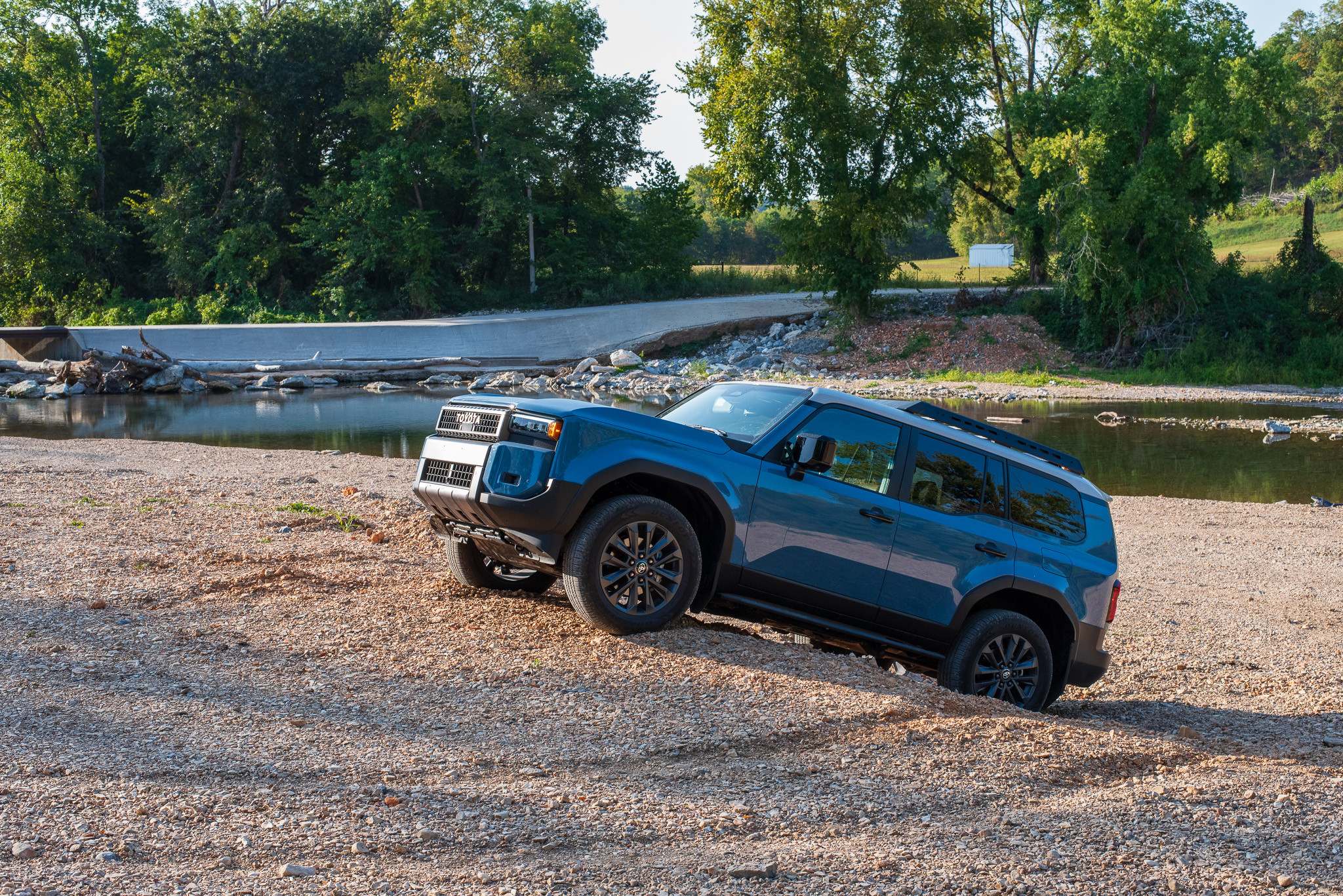 Side view of the 2024 Toyota Land Cruiser driving on a paved road, showing its stance and profile.
Side view of the 2024 Toyota Land Cruiser driving on a paved road, showing its stance and profile.
That’s not to say the Land Cruiser is completely devoid of enthusiast features. My test vehicle included a push-button sway bar disconnect, Multi-Terrain Select for optimized wheel slip control, and Crawl Control. The 360-degree camera system, which I consider essential for any modern 4×4, provided a comprehensive view of the vehicle’s surroundings. These features function as advertised, arguably making the Land Cruiser more capable off-road than on paved roads.
However, Toyota’s aim wasn’t to create a high-performance SUV. The Land Cruiser’s 8.7 inches of ground clearance is slightly less than the Lexus GX’s already modest figure. Its minimal overhangs are an advantage, providing a maximum approach angle of 31 degrees compared to the Lexus’ 26 degrees. This helped it navigate a steep gravel incline at our test location without excessive scraping.
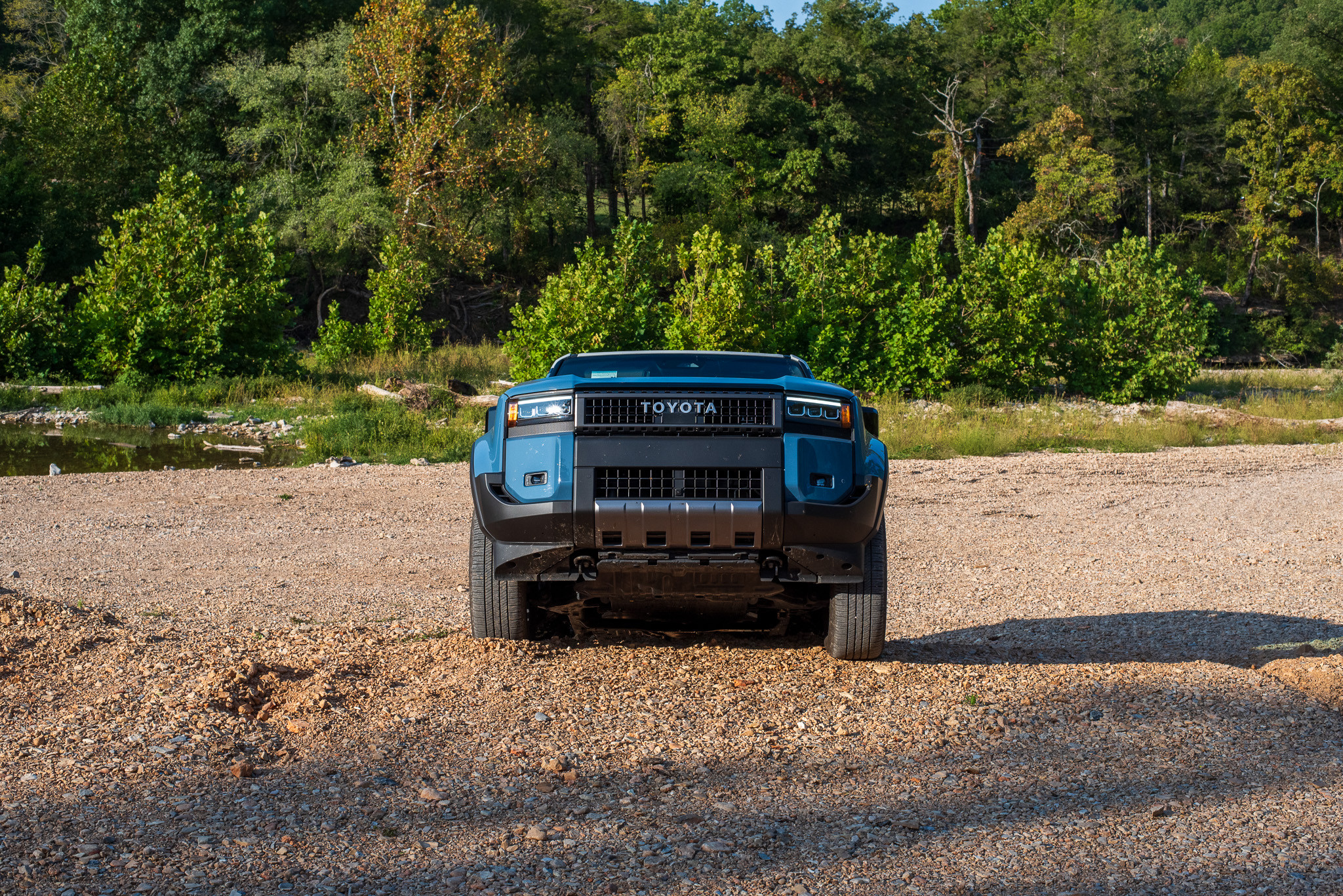 Front view of the 2024 Toyota Land Cruiser climbing a gravel hill, showcasing its off-road capability.
Front view of the 2024 Toyota Land Cruiser climbing a gravel hill, showcasing its off-road capability.
Despite the good approach angle, I did feel the Land Cruiser scrape its underbelly when cresting the hill. The Land Cruiser’s breakover angle is actually less favorable than the GX at 22 degrees compared to 24, although its departure angle is slightly better at 25 degrees versus the Lexus’ 22 degrees.
The Land Cruiser excels in low-speed, technical off-road situations. This is where its driving experience is most enjoyable. It would be even better if it could sustain electric-only mode for longer periods, but the engine engages quickly with a rather uninspired sound, more noticeable through the firewall than from the exhaust.
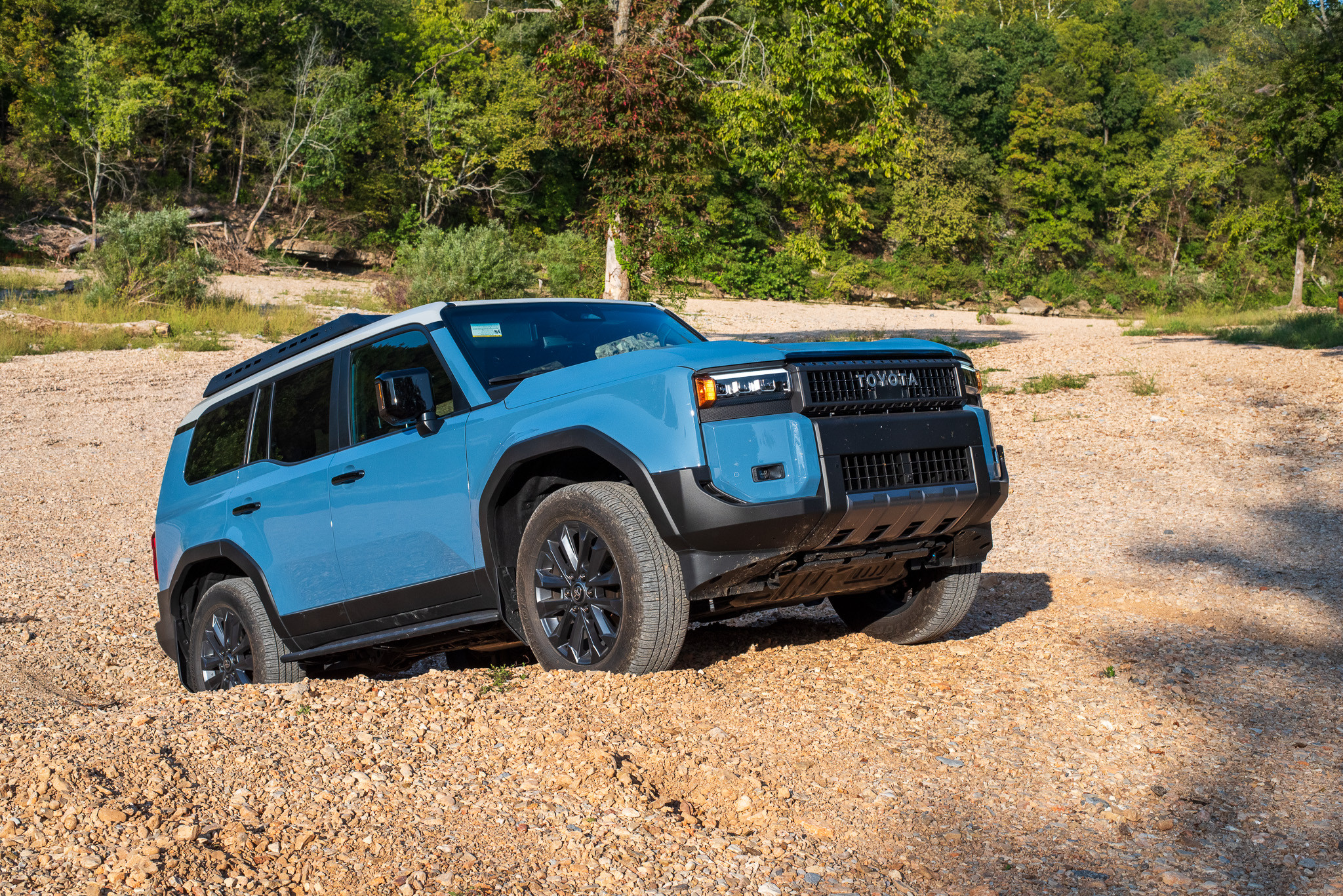 Front three quarter view of the 2024 Toyota Land Cruiser driving on a dirt trail, highlighting its off-road environment.
Front three quarter view of the 2024 Toyota Land Cruiser driving on a dirt trail, highlighting its off-road environment.
On open roads, the Land Cruiser simply doesn’t feel like a $70,000 vehicle. Given that the base model is quite basic, it’s hard to believe it feels like a $58,000 vehicle in its entry configuration either. It lacks even endearing flaws, such as heavy steering or turbo lag; it just feels numb and unengaging.
My disappointment was amplified by having just driven the Lexus GX the week before. Back-to-back drives clearly highlighted the Land Cruiser’s shortcomings. It’s not as capable off-road, primarily because it lacks the GX’s advanced E-KDSS system. It’s less enjoyable on-road due to the uninspiring hybrid powertrain and driving experience. And despite costing more in top trim, it doesn’t offer a more luxurious interior than the GX Overtrail.
Land Cruiser: Ups and Downs
One undeniable strength of the Land Cruiser is its respectable off-road performance in its stock configuration. It confidently climbs challenging terrains with ample traction from its full-time 4WD and locking rear differential. While the torque delivery might not feel dramatic, it’s certainly present, particularly at lower speeds. It doesn’t immediately require extensive aftermarket upgrades to become trail-ready, which is expected of a Land Cruiser.
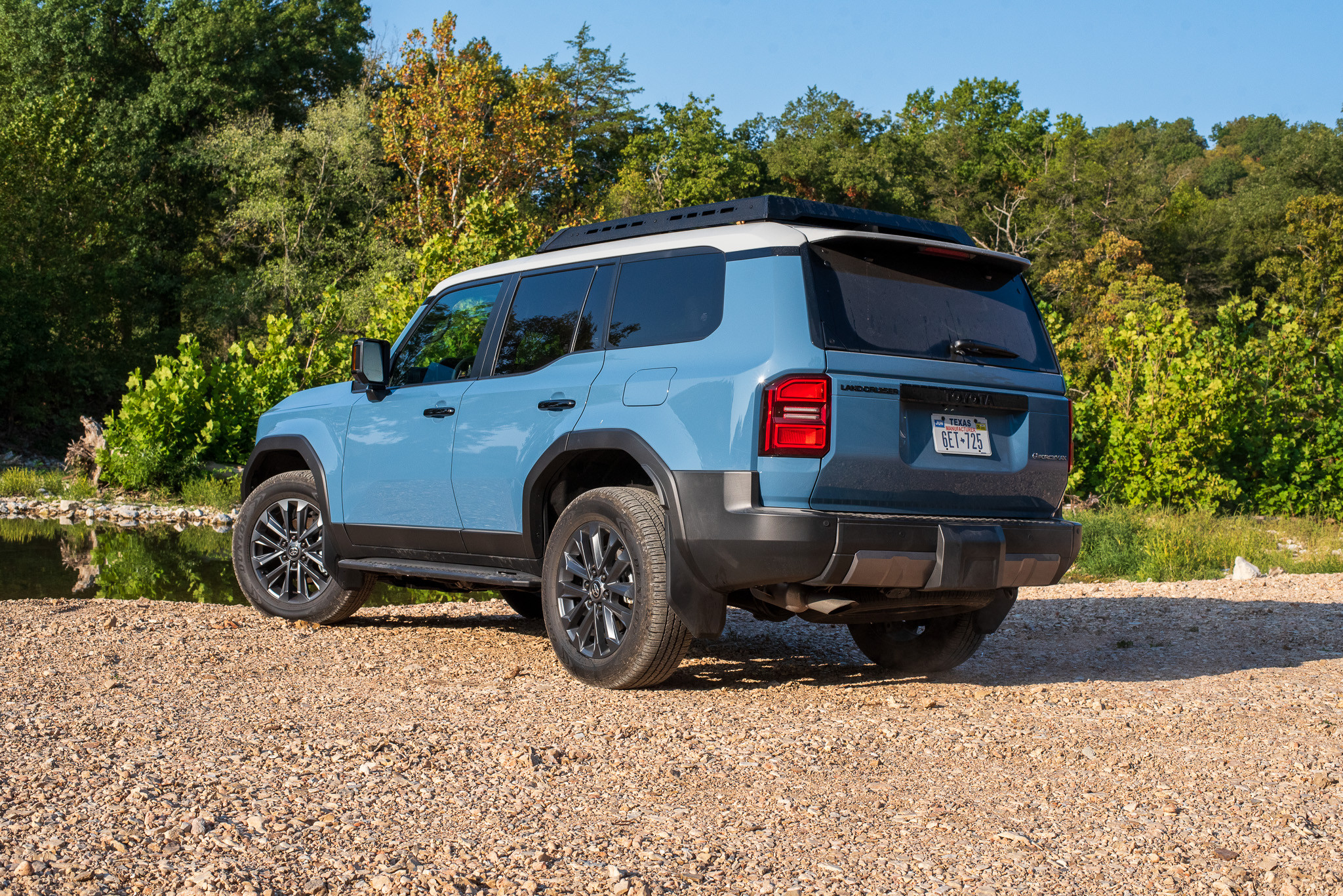 Front view of the 2024 Toyota Land Cruiser parked on a rocky terrain, emphasizing its off-road ready appearance.
Front view of the 2024 Toyota Land Cruiser parked on a rocky terrain, emphasizing its off-road ready appearance.
However, it’s difficult to accept this new model as a true successor to the 200 Series. It lacks the robustness and solidity that defined that generation. If it were branded as a “Land Cruiser Lite” or similar, it would be more palatable. But as a direct Land Cruiser replacement, it feels less substantial and tough. Early reports of water leaks and engine issues further undermine its reputation for long-term durability.
Features, Options, and Market Rivals
There is a significant gap between the two Land Cruiser trims: the 1958 and the “Land Cruiser”. The 1958 trim offers a basic cabin with cloth seats and a smaller screen, while the higher “Land Cruiser” trim features richer SofTex upholstery and more advanced technology. Beyond trim levels, option choices are limited, mainly consisting of dealer-installed accessories like rock rails and floor mats.
The Premium Package, available on the top-tier Land Cruiser trim, represents the most comprehensive upgrade. At $4,600, it includes the 14-speaker JBL Premium Audio system, illuminated entry, power moonroof, refrigerated center console, digital rearview mirror, wireless charger, head-up display, and safety features like lane change assist and front cross-traffic alert. Optional 20-inch alloy wheels are also available for $1,240, even for those planning off-road use.
 Front three quarter view of the 2024 Toyota Land Cruiser parked showing its alloy wheels and premium trim details.
Front three quarter view of the 2024 Toyota Land Cruiser parked showing its alloy wheels and premium trim details.
The Land Cruiser’s competitive landscape is somewhat ambiguous. It’s not a hardcore 4×4 in the vein of the Jeep Wrangler or Ford Bronco, nor is it as luxurious as a Land Rover Defender. In terms of ethos, it’s closest to its stablemate, the 4Runner, although Toyota positions them differently. Classifying it as a midsize SUV puts it in competition with vehicles like the Kia Telluride and Mazda CX-90, which feels inaccurate. It occupies a unique space in the market, especially with its starting price near $58,000.
Fuel Efficiency
The Land Cruiser’s fuel economy is a notable point of comparison. It achieves significantly better mileage than its twin-turbo V6-powered Lexus GX counterpart. The GX’s combined 17 mpg is hard to justify in today’s market. The Toyota also outperforms the standard Ford Bronco in fuel efficiency, likely due to its hybrid system. However, it falls slightly behind the Mazda CX-90 with its mild-hybrid, turbocharged 3.3-liter inline-six.
Value and Final Verdict
I genuinely wanted to be enthusiastic about the new Land Cruiser. I wanted to recommend it as a worthwhile purchase, celebrating the return of a Toyota 4×4 legend to the U.S. market.
However, I cannot wholeheartedly endorse it. It’s impossible to give it a strong recommendation when the Lexus GX offers a superior package for roughly the same price.
Furthermore, my reservations about the new Land Cruiser are amplified by its attempt to replace the V8-powered 200 Series. To me, this feels almost disrespectful. Not because the previous Land Cruiser was flawless (though it was undeniably excellent), but because drastically reducing the cylinder count, adding a battery and electric motor, and downgrading other aspects while presenting it as the same iconic vehicle is misleading. It’s simply not the same. Personally, I wouldn’t choose it, and unless there’s a compelling aspect I’m overlooking, it’s hard to understand why others would either.
| 2024 Toyota Land Cruiser Specs |
|---|
| Base Price (as tested) |
| Powertrain |
| Horsepower |
| Torque |
| Seating Capacity |
| Cargo Volume |
| Curb Weight |
| Ground Clearance |
| Off-Road Angles |
| Max Towing |
| EPA Fuel Economy |
| Quick Take |
| Score |